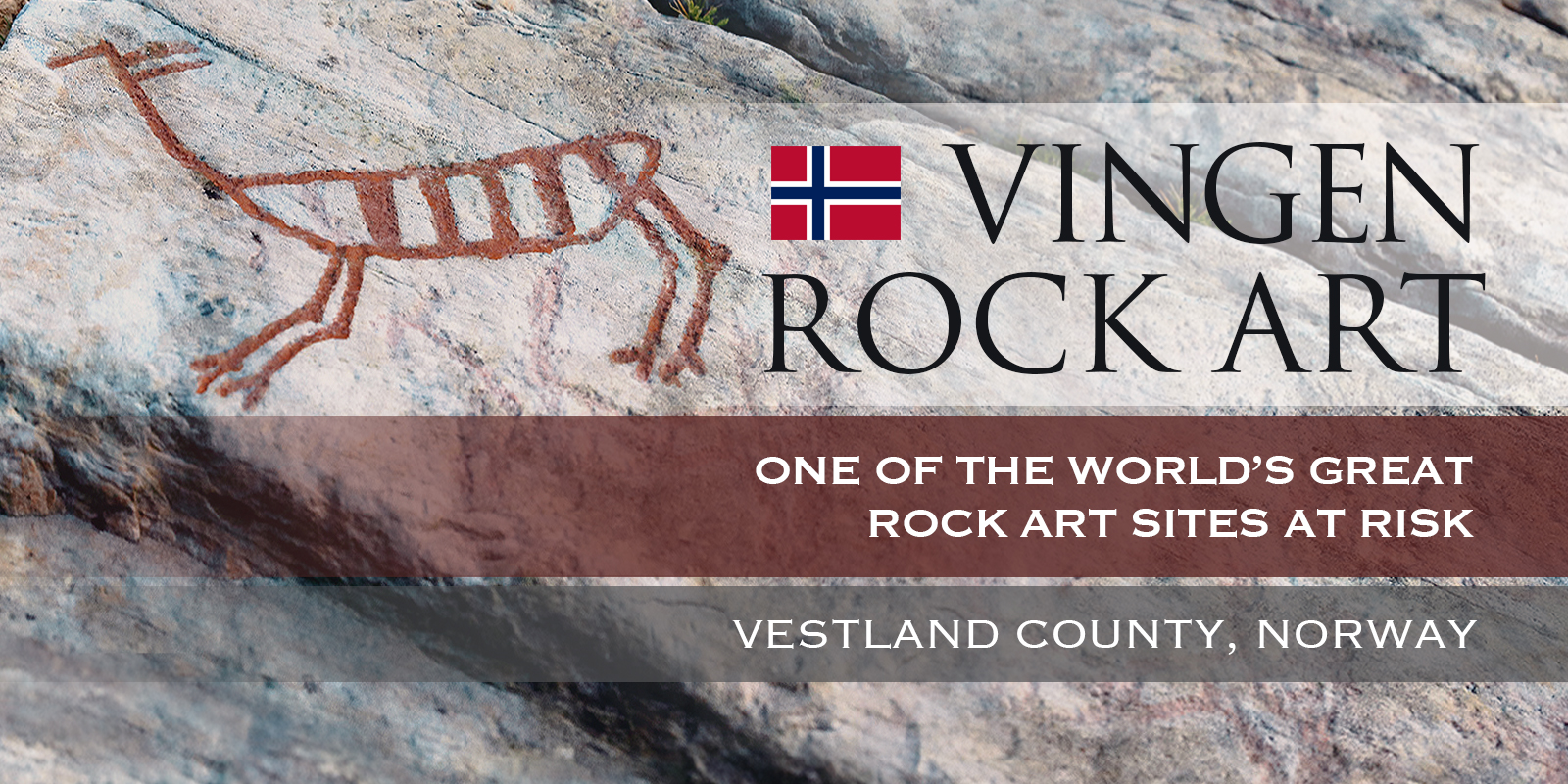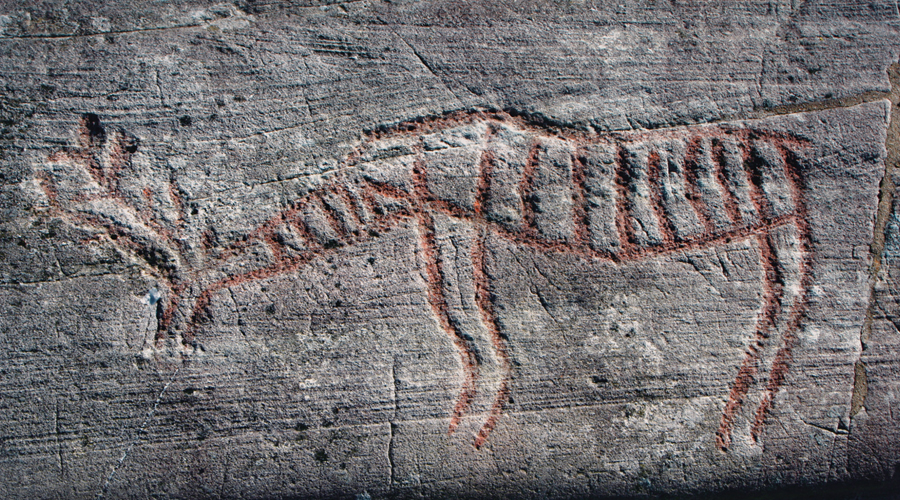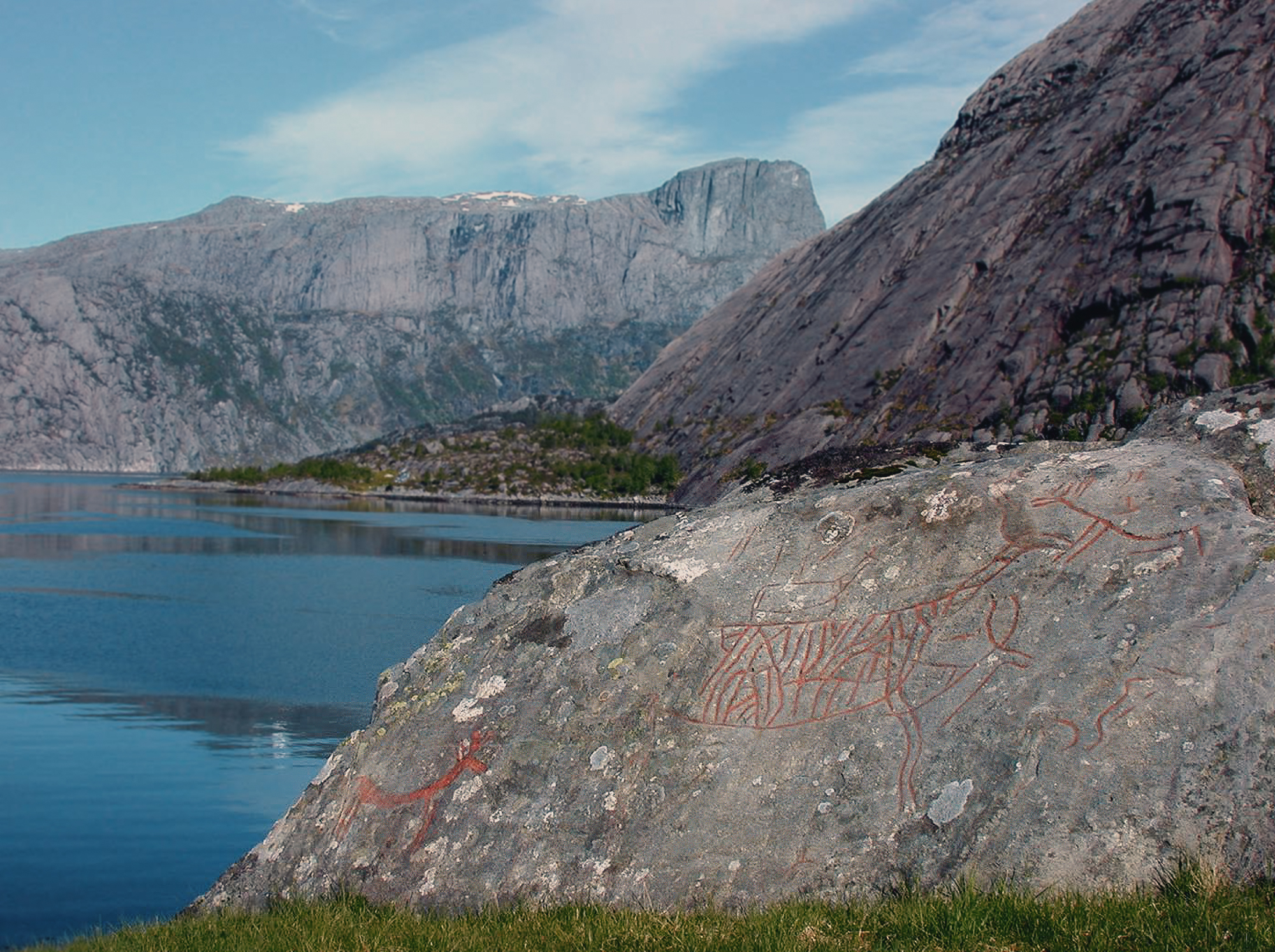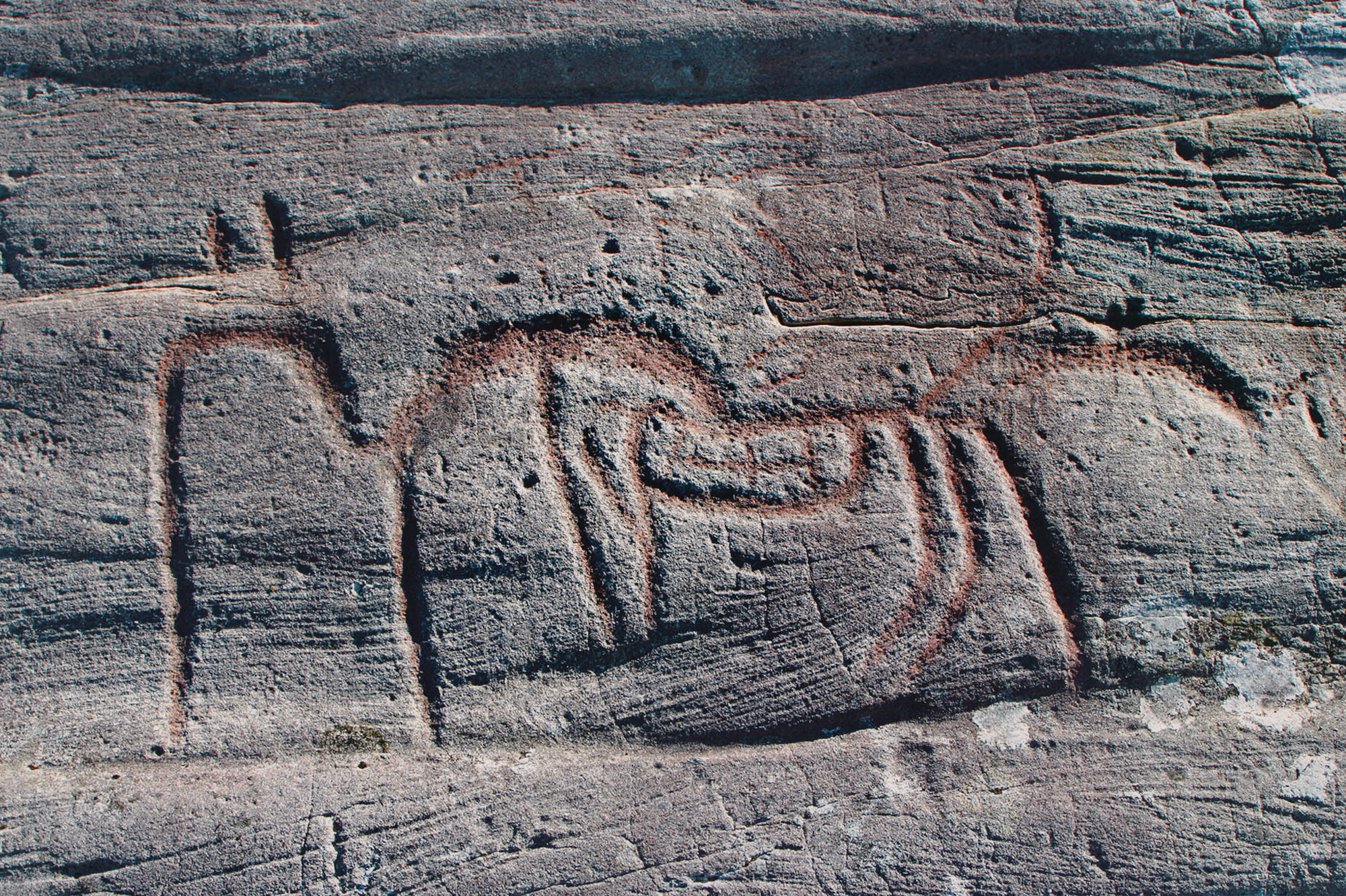


By Dr George Nash
Associate Professor, Geosciences Centre, University of Coimbra, Portugal and Research Fellow within the Department of Archaeology, Classics and Egyptology, University of Liverpool We live in a world where mineral extraction sometimes takes priority over the environment, as witnessed in many countries with a poor planning system. In the case of the Vingen debacle in western Norway, we can also include threats to cultural heritage, geology and ecology.
As many of you may be aware, a rock art site in western [coastal] Norway is under threat from a major quarrying development that will severely impact the environment in which the rock art stands, along with other forms of archaeology.1 The rock art, displaying hunter/fisher/gatherer imagery dates to the [Northern European] Early Stone Age and numbering at least 2000 engravings. Similar to other prehistoric rock art sites in Norway, the Vingen site is statutory protected under Norwegian Heritage Law. This short article briefly looks at the Norwegian planning system and asks, why has Vingen slipped through the net?
…the surroundings in which a heritage asset is experienced. Its extent is not fixed and may change as the asset and its surroundings evolve. Elements of a setting may make a positive or negative contribution to the significance of an [heritage] asset, may affect the ability to appreciate that significance or may be neutral.2
Any development, be it housing or in this case extensive quarrying, the setting of cultural heritage will be impacted upon. Again, using English planning terminology, cultural heritage can be harmed by ‘direct’ and ‘indirect’ impacts. Direct impacts are considered physical harm to a heritage asset and it is probable that as yet undiscovered rock art and other forms of archaeology (such as historic buildings/structures, and below-ground archaeology) may be physically harmed should the proposed quarrying go ahead. An indirect impact is the harm caused by development that stands next to or is within view of cultural heritage. An indirect impact can also include noise pollution. The greater the value of the cultural heritage, the greater the impact. I would therefore ask, would a planning authority authorise a housing development or quarrying scheme next to, say, a World Heritage Site – most probably not.
Rock art is artistically compelling and full of meaning. This fragile and irreplaceable visual heritage has worldwide significance. If we neglect, destroy, or disrespect rock art we devalue our future.
© Trond Lødøen
- Local and regional public opinion;
- International opinion;
- Expert opinion; resulting in a public enquiry and transparent impact statement;
-
A review of the planning paperwork concerning the proposed quarrying development. Is the National Government aware of all the facts and the potential severe impact to Vingen (no rubber stamp exercise here please)? Having looked through the Directorate for Cultural Heritage Strategy (2017-21),3 the first couple of paragraphs of this document says it all:
Norwegians show a strong interest in history and the cultural heritage, and many owners and volunteers are deeply committed to the conservation and maintenance of buildings, monuments and sites. As a result, there is considerable potential for innovative use and management of the cultural heritage.
Norway is undergoing many changes. The industrial structure and settlement patterns are changing, and urbanisation is putting pressure on valuable historical buildings and the built environment in towns and built-up areas. At the same time, rural areas are experiencing depopulation. Major road and railway construction projects have impacts on the cultural landscape and archaeological monuments and sites. In a wider perspective, Norway too is being affected by global trends including climate and environmental change and population displacements.
Norway has national targets for the cultural heritage that are to be achieved by 2020. They include protecting a more representative selection of the cultural heritage, reducing losses of cultural monuments and sites, and implementing various conservation plans.
In terms of achieving certain targets for the protection of Cultural Heritage, I draw the reader to:
The targets for the priority area ‘cultural heritage’ are as follows:
Target 2.1. Losses of cultural monuments and sites will be minimised. By 2020, each municipality will have an overview of its cultural heritage as a basis for identifying a selection of monuments, sites and environments for conservation.
Target 2.3. By 2020, a representative selection of cultural monuments, sites and environments will be protected by individual protection orders.
So, the positive rhetoric is already in place; Norway, please use it for Vingen!
- A revision of the cultural heritage value of the rock art and the environment in which it stands (i.e., does Vingen deserve World Heritage Site status?) I would refer readers to the near-catastrophe of the Côa Valley in NE Portugal debacle during the 1990s where an imminent dam project threated the archaeology and landscape. The valley and its tributaries were granted World Heritage Site status in 1998 (please read ‘Citation 1 of the Côa Valley Inscription’ which mirrors the significance of Vingen).4 The discovery of up to 1300 engraved panels displaying Upper Palaeolithic rock art rewrote the ancient history of SW Europe.
Rock art is artistically compelling and full of meaning. This fragile and irreplaceable visual heritage has worldwide significance. If we neglect, destroy, or disrespect rock art we devalue our future.
© Universitetet i Bergen
Finally, when considering an impact on a proposed development such as the extensive quarrying scheme at Vingen, the significance of the cultural heritage (i.e., the rock art) should be paramount to Vingen’s conservation, including sustaining its significance. The Planning Authority in Vestland, please wake up!
Anyone wishing to understand more about this remarkable rock art site and its archaeological history, see Hallström (1938, 415-57) (chapter enclosed as a PDF) and an excellent account of the site, with stunning imagery, see Mandt & Lødøen (2005, 134-57). Hallström’s account probably gives the most detailed account of the various animals displayed on the open-air panels. What is unique is the infill decoration for numerous cervids and elk, a characteristic of Norwegian prehistoric hunter/fisher/gatherer rock art. Also, look at Bing (1912) who was the first scientist to report on Vingen’s rock art.
Bing, K., 1912. Helleristningsfund ved garden Vingen I Rugsund. Ytre Nordfjord Oldtiden 2, 25-39.
Hallström, G., 1938. Monumental Art of Northern Europe from the Stone Age. 1,. The Norwegian Localities. Stockholm.
Mandt, G. & Lødøen, T., 2005. Bergkunst: Helleristninger I Noreg. Det Norske Sam Laget, Oslo.
1 https://www.theguardian.com/world/2024/mar/02/battle-to-save-pristine-prehistoric-rock-art-quarry-vingen-carvings-vestland-norway
2 https://historicengland.org.uk/images-books/publications/gpa3-setting-of-heritage-assets/heag180-gpa3-setting-heritage-assets/
3 https://ra.brage.unit.no/ra-xmlui/bitstream/handle/11250/2442341/RA_strategy_2017_2021_engelsk.pdf
4 https://whc.unesco.org/en/list/866
→ Vingen Rock Art In Norway - Index
→ Film: Vingen Rock Art in Norway
→ Paul Taçon - Griffith University letter
→ Norway's Vingen Rock Art Petroglyphs at Risk
→ ICOMOS Statement on Vingen
→ Knowing when to back down: The plight of the Vingen rock art site, western Norway
→ Norway preserves world heritage abroad but not in Norway?
→ Vingen - A Century of Rock Art Research & Cultural Heritage
→ History of Vingen Rock Art in Norway
→ Valuing Cultural Heritage
→ Norway's Confusing Messages
→ Members and affiliated institutions of the Rock Art Network
→ Film: Vingen Rock Art in Norway
by Bradshaw Foundation
20/02/2024 Vingen Recent Articles
NORWAY
→ Knowing when to back down: The plight of the Vingen rock art site, western Norway
by George Nash
4/03/2024
→ Norway preserves world heritage abroad but not in Norway?
by Bradshaw Foundation
20/02/2024
→ Valuing Cultural Heritage
by Ben Dickiins
20/02/2024
→ Norway's Confusing Messages
by Peter Robinson
20/02/2024
→ Paul Taçon - Griffith University letter regarding the Aksla quarry and Inste Bårdvikneset quay developments in Norway
by Paul Taçon
13/02/2024
→ Norway's Vingen Rock Art Petroglyphs at Risk
by Rock Art Network
13/02/2024
→ Professor Benjamin Smith President, ICOMOS International Scientific Committee on Rock Art calls for an immediate review of the decision to allow a rock quarry and a shipping quay to be built at one of the most significant rock art sites in Europe: Vingen.
by Rock Art Network
8/02/2024
→ Vingen - A Century of Rock Art Research & Cultural Heritage
by Trond Lødøen / Ben Dickins
6/02/2024
→ History of Vingen Rock Art in Norway
by Trond Lødøen
1/01/2018


→ Knowing when to back down: The plight of the Vingen rock art site, western Norway
by George Nash
4/03/2024
→ Norway preserves world heritage abroad but not in Norway?
by Bradshaw Foundation
20/02/2024
→ Valuing Cultural Heritage
by Ben Dickiins
20/02/2024
→ Norway's Confusing Messages
by Peter Robinson
20/02/2024
→ Paul Taçon - Griffith University letter regarding the Aksla quarry and Inste Bårdvikneset quay developments in Norway
by Paul Taçon
13/02/2024
→ Norway's Vingen Rock Art Petroglyphs at Risk
by Rock Art Network
13/02/2024
→ Professor Benjamin Smith President, ICOMOS International Scientific Committee on Rock Art calls for an immediate review of the decision to allow a rock quarry and a shipping quay to be built at one of the most significant rock art sites in Europe: Vingen.
by Rock Art Network
8/02/2024
→ Vingen - A Century of Rock Art Research & Cultural Heritage
by Trond Lødøen / Ben Dickins
6/02/2024
→ History of Vingen Rock Art in Norway
by Trond Lødøen
1/01/2018
Friend of the Foundation


→ Knowing when to back down: The plight of the Vingen rock art site, western Norway
by George Nash
4/03/2024
→ Norway preserves world heritage abroad but not in Norway?
by Bradshaw Foundation
20/02/2024
→ Valuing Cultural Heritage
by Ben Dickiins
20/02/2024
→ Norway's Confusing Messages
by Peter Robinson
20/02/2024
→ Paul Taçon - Griffith University letter regarding the Aksla quarry and Inste Bårdvikneset quay developments in Norway
by Paul Taçon
13/02/2024
→ Norway's Vingen Rock Art Petroglyphs at Risk
by Rock Art Network
13/02/2024
→ Professor Benjamin Smith President, ICOMOS International Scientific Committee on Rock Art calls for an immediate review of the decision to allow a rock quarry and a shipping quay to be built at one of the most significant rock art sites in Europe: Vingen.
by Rock Art Network
8/02/2024
→ Vingen - A Century of Rock Art Research & Cultural Heritage
by Trond Lødøen / Ben Dickins
6/02/2024
→ History of Vingen Rock Art in Norway
by Trond Lødøen
1/01/2018
Friend of the Foundation

















